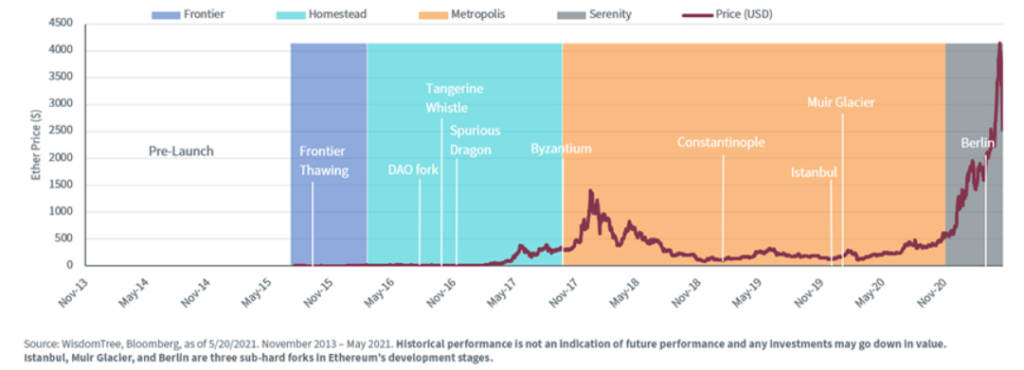Introduction
The crypto community commemorates the 8th anniversary of the Ethereum network, which marks eight years since its official launch by the Ethereum Foundation. On July 30, 2015, Stephan Tual, the former Ethereum Foundation CCO, shared the exciting news through a blog post, confirming the network’s successful rollout.
“The vision of a censorship-proof world computer that anyone can program, paying exclusively for what they use and nothing more, is now a reality,” he wrote.
After eight years, Ethereum and its native cryptocurrency, Ether (ETH), have achieved remarkable growth. Ether is currently valued at $1,865, and Ethereum is the second-largest cryptocurrency worldwide, with a substantial market capitalization of $225 billion. Notably, the platform enjoys the active involvement of over 1,900 developers each month, reflecting its robust and thriving ecosystem.
Evolution of Ethereum
Ethereum’s development was carefully planned and executed through four main stages, each signifying a crucial network-wide upgrade known as a “hard fork.” These stages aimed to enhance the platform and discontinue support for older versions.
Stage 1: Frontier
The initial phase, “Frontier,” spanned from July 30, 2015, to March 14, 2016. Ethereum 1.0 was launched during this period, providing two fundamental functionalities: enabling users to mine Ether (the native cryptocurrency) and execute smart contracts. The primary objective of this stage was to kick-start the network, allowing miners to set up their mining operations and developers to test their decentralized applications (DApps).
Following Frontier, a minor upgrade called “Frontier Thawing” was introduced. It limited gas (transaction fees) to 5,000 per transaction to ensure fees remained reasonable and didn’t impede widespread usage of the platform. This measure aimed to balance cost-effectiveness and foster broader adoption of Ethereum’s capabilities.
Stage 2: Homestead
From March 14, 2016, to October 16, 2017, Ethereum entered its “Homestead” phase, dedicated to enhancing the platform’s infrastructure to address security concerns.
After the initial “Frontier” phase, the community recognized the importance of bolstering Ethereum’s security. The infamous DAO hack in 2016 exposed a vulnerability in the system, leading to the theft of funds from the decentralized autonomous organization. To rectify the situation, a contentious decision was made to implement a hard fork, creating a safer version of Ethereum called “Homestead.”
The DAO incident also resulted in a divergence within the community, leading to the creation of Ethereum Classic, as some members disagreed with the hard fork decision.
Furthermore, during this phase, Ethereum faced denial-of-service (DoS) attacks, prompting the release of two sub-upgrades named “Tangerine Whistle” and “Spurious Dragon.” These upgrades were designed to improve security by adjusting gas fees (transaction costs) and implementing state-clearing mechanisms.
Ethereum strengthened its infrastructure through these crucial upgrades, enhancing its resilience and security to pave the way for further growth and adoption in the decentralized ecosystem.

Stage 3: Metropolis
From October 16, 2017, to January 2, 2020, Ethereum entered the “Metropolis” phase, addressing challenges related to its expansion and growth. Metropolis aimed to comprehensively improve the platform’s security, privacy, and scalability, catering to the increasing demands of its expanding user base.
The Metropolis upgrade was executed in two stages to tackle these complexities: Byzantium and Constantinople. Byzantium comprised nine Ethereum Improvement Protocols (EIPs) patches, introducing vital features like zk-SNARKs (zero-knowledge proofs), account abstraction, and the difficulty bomb.
However, the Constantinople phase faced delays due to a critical bug discovered just before its launch in mid-2018. Nevertheless, it eventually succeeded in building upon the advancements of Byzantium and resolving any issues that arose from its implementation.
Furthermore, Constantinople laid the groundwork for Ethereum’s transition from a proof-of-work (PoW) to a proof-of-stake (PoS) consensus mechanism. This shift will significantly reduce the network’s energy consumption for validation, making it more sustainable and environmentally friendly.
Overall, the Metropolis phase played a vital role in enhancing Ethereum’s capabilities, making it more efficient and user-friendly for developers and users.
Stage 4: Serenity
From January 2, 2020, to the present day, Ethereum has been progressing toward its transformative “Serenity” phase, commonly referred to as Ethereum 2.0. This ambitious upgrade addresses crucial issues hindering its broader adoption and usability.
The main focus of Ethereum 2.0 is to overcome two significant challenges the current network faces. Firstly, the existing system experiences congestion, allowing only a limited number of transactions per second, leading to higher gas fees for faster transactions. Secondly, Ethereum’s current proof-of-work consensus mechanism consumes significant energy, impacting its sustainability and environmental footprint.
To tackle these challenges, Ethereum 2.0 introduces two significant upgrades. The first is transitioning from the energy-intensive proof-of-work to the more sustainable proof-of-stake consensus mechanism. This shift will significantly reduce the network’s energy consumption, making it more environmentally friendly and scalable.
The second significant enhancement involves the implementation of shard chains. These shard chains will effectively distribute the network’s workload, enhancing scalability and improving Ethereum’s efficiency in handling a more significant number of transactions.
Despite the promising vision of Ethereum 2.0, it is essential to note that the development process is ongoing, and certain uncertainties persist. The exact timeline for its full implementation remains uncertain, and the Ethereum community is still addressing potential challenges or implications that may arise in the transition.
How to buy Ethereum in India?
Bitcoiva is one of the world’s leading crypto exchange platforms in India that allows buying/selling ETH via the following simple steps.
- Register
- Verify KYC
- Deposit
- Buy/Sell ETH
Conclusion
In summary, Ethereum 2.0 promises to make the platform more scalable, secure, and sustainable, ultimately paving the way for broader usage and a more efficient decentralized ecosystem.
Visit us at: www.bitcoiva.com

